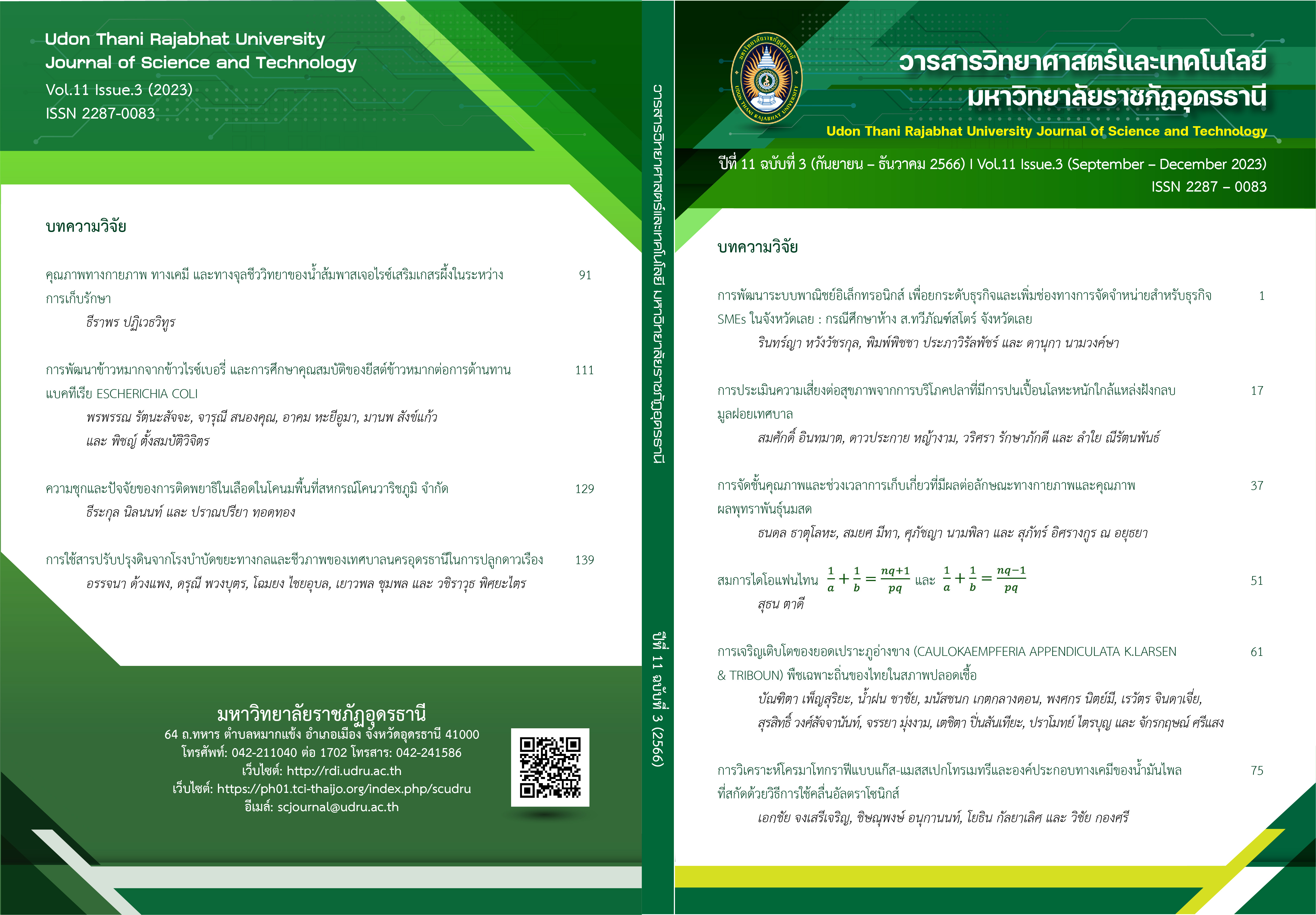การพัฒนาข้าวหมากจากข้าวไรซ์เบอรี่ และการศึกษาคุณสมบัติของยีสต์ข้าวหมากต่อการต้านทานแบคทีเรีย ESCHERICHIA COLI
Main Article Content
บทคัดย่อ
ข้าวหมากเป็นอาหารหมักด้วยจุลินทรีย์จากภูมิปัญญาไทย อย่างไรก็ตามข้าวหมากแม้จะมีงานวิจัยมากมายที่ระบุถึงประโยชน์ต่อผู้บริโภค แต่ข้าวหมากก็ยังไม่เป็นที่นิยมในการบริโภคมากนัก ดังนั้นงานวิจัยนี้มีวัตถุประสงค์เพื่อ พัฒนาข้าวหมากจากข้าวไรซ์เบอรี่ โดยกำหนดสูตรข้าวหมาก 3 สูตร คือ ข้าวหมากข้าวเหนียวขาว ข้าวหมากข้าวไรซ์เบอรี่ผสมข้าวหมากข้าวเหนียวขาว อัตราส่วน 50:50 และ ข้าวหมากข้าวไรซ์เบอรี่ ผลการทดลองพบว่า ข้าวหมากข้าวไรซ์เบอรี่ที่หมัก 3 วัน มีความหวานเฉลี่ยน้อยที่สุด เท่ากับ 16.9±0.4% และ ปริมาณแอลกอฮอล์เฉลี่ยต่ำที่สุด เท่ากับ 0.58±0.03% อย่างมีนัยสำคัญทางสถิติ ผลการทดลองคุณค่าทางอาหาร พบว่า ข้าวหมากข้าวไรซ์เบอรี่มีโปรตีนและใยอาหารสูงที่สุด เท่ากับ 6.33±0.09 และ 5.24±0.06 กรัมต่อ 100 กรัม ตามลำดับ เมื่อเทียบกับข้าวหมากอีก 2 สูตร รวมทั้งข้าวหมากข้าวไรซ์เบอรี่ มีปริมาณฟีนอลิกทั้งหมด เท่ากับ 71.10±0.25 มิลลิกรัมต่อ 100 กรัม มีสารต้านอนุมูลอิสระ เท่ากับ 194.60±3.10 ไมโครโมลต่อ 100 กรัม และมีความสามารถยับยั้งอนุมูลอิสระดีที่สุดอย่างมีนัยสำคัญทางสถิติ เท่ากับ 87.56% ในขณะที่ข้าวหมากทั้ง 3 สูตรสามารถตรวจพบยีสต์ที่มีประสิทธิภาพยับยั้งการเจริญของเชื้อแบคทีเรีย Escherichia coli ผลการทดลองพบว่า ยีสต์ไอโซเลทจากข้าวหมากข้าวเหนียวขาว (W15) และยีสต์ไอโซเลทจากข้าวหมากข้าวไรซ์เบอรี่ (B1) มีเส้นผ่านศูนย์กลางวงใส เท่ากับ 11.67±0.11 และ 9.80±0.20 มิลลิเมตร ตามลำดับ เมื่อระบุบ่งชี้สายพันธุ์ยีสต์ในข้าวหมากระดับพันธุกรรมของยีสต์ด้วยวิธีการ sequencing บริเวณตำแหน่งจำเพาะ 2 บริเวณ คือ Internal transcribed spacer (ITS region) และบริเวณ 26S rRNA พบว่า ยีสต์ไอโซเลท W15 และ B1 คือ Saccharomycopsis fibuligera เช่นเดียวกัน
Article Details
เอกสารอ้างอิง
เจนจิรา เดชรักษา และ ดวงเดือน วัฏฏานุรักษ์. (2564). การยับยั้งแบคทีเรียจากสารสกัดข้าวหมากมีสี. วารสารวิจัยและนวัตกรรมทางวิทยาศาสตร์ มหาวิทยาลัยราชภัฎวไลยอลงกรณ์ ในพระบรมราชูปถัมภ์, 2(3), 92-105.
ชื่นจิต สีพญา. (2558). ไรซ์เบอร์รี่ ข้าวดี มีประโยชน์. สืบค้นเมื่อวันที่ 28 มิถุนายน 2562, จาก http://lib3.dss.go.th/fulltext/dss_knowledge/bsti_11_2558_Riceberry.pdf.
ผาณิต รุจิรพิสิฐ, วิชชุดา สังข์แก้ว และ เสาวนีย์ เอี้ยวสกุลรัตน์. (2555). คุณค่าทางโภชนาการของข้าว 9 สายพันธุ์. วารสารวิทยาศาสตร์เกษตร, 43 (ฉบับพิเศษ 2), 173-176.
ศูนย์วิทยาศาสตร์ข้าว มหาวิทยาลัยเกษตรศาสตร์. (2566). ข้าวไรซ์เบอรี่ Riceberry. สืบค้นเมื่อวันที่ 3 เมษายน 2564, จาก: https://dna.kps.ku.ac.th/index.php/research- develop/rice-breeding-lab/riceberry-variety.
อรุณ ชาญชัยเชาว์วิวัฒน์, สมเกียรติ พรพิสุทธิมาศ และ เกร็ดแก้ว มุขแสง. (2558). การวิเคราะห์และเปรียบเทียบยีสต์บีตากลูแคนจากลูกแป้งข้าวหมากในภาคกลางของประเทศไทย. วารสารหน่วยวิจัยวิทยาศาสตร์ เทคโนโลยี และสิ่งแวดล้อมเพื่อการเรียนรู้, 6(2), 188-197.
อุไรวรรณ วัฒนกุล, ชุตินุช สุจริต และ นพรัตน์ วงศ์หิรัญเดชา. (2555). คุณค่าทางโภชนาการบางประการในข้าวหมากที่ผลิตจากข้าวสังข์หยดพัทลุง. น. 721-729. ใน: การประชุมวิชาการแห่งชาติ ครั้งที่ 9. 6-7 ธันวาคม 2555. มหาวิทยาลัยเกษตรศาสตร์ วิทยาเขตกำแพงแสน.
AOAC. (2016). Official methods of analysis. Maryland, USA: AOAC International.
Chachaichaovivat, A. (2010). Yeast betaglucan: Food supplement for immune system. Journal of Research Unit on Science, Technology and Environment for Learning, 1(2), 113–118. (in Thai)
Chanchaichaovivat, A., & Pasuk, A. (2013). Inhibitory Effect of Fermented Glutinous Rice on Enteropathogenic Bacteria. The Journal of Interdisciplinary Networks, 2(2), 30-36.
Demir, G., Klein, H. O., Mandel-Molinas, N., & Tuzuner, N. (2007). Beta glucan induces proliferation and activation of monocytes in peripheral blood of patients with ad-vanced breast cancer. International im-munopharmacology, 7(1), 113–116.
Hong, F., Yan, J., Baran, J. T., Allendorf, D. J., Hansen, R. D., Ostroff, G R., Xing, P. X., Cheung, N. K., & Ross, G. D. (2004). Mechanism by which orally administered β-1,3-glucans enhance the tumoricidal activity of antitumor monoclonal antibodies in murine tumor models. Journal of Immunology, 173(2), 797–806.
Kim, D. H., Jeong, D., Kim, H., Kang, I. B., Chon, J. W., Song, K. Y., & Seo, K. H. (2016). Antimicrobial activity of kefir against various food pathogens and spoilage bacteria. Korean Journal for Food Science of Animal Resources, 36(6), 787-790.
Kogan, G., Stasko, A., Bauerova, K., Polovka, M., Soltes, L., Brezova, V., & Navarova, J. (2005). Antioxidant properties of yeast (1,3)-β-D-glucan studied by electron paramagnetic resonance spectroscopy and its activity in the adjuvant arthritis. Carbohydrate Polymers, 61(1), 18–28.
Limtong, S., Sintara, S., Suwanarit, P., & Lotong, N. (2002). Yeast diversity in Thai traditional fermentation starter (loog-pang). Kasetsart Journal Natural Science, 36, 149-158.
Limtong, S., Sintara, S., Suwanarit, P., & Lotong, N. (2005). Species diversity of molds in Thai traditional fermentation starters (Long-pang). Kasetsart Journal Natural Science, 39, 511-518.
Maikaeo, L., Sajjabut, S., & Thepthong, P. (2019). Total Phenolic Content, Antioxidant and Antiproliferative Activities of Methanolic Extract from Flowers, Twigs and Peels of Mammea siamensis. Thai Journal of Pharmacology, 41(1), 5-12.
Manosroi, A., Ruksiriwanich, W., Kietthankorn, B., Manosroi, W., & Manosroi, J. (2011). Relationship between biological activities and bioactive compounds in the fermented rice sap. Food Research International, 44, 2757–2765.
Mongkontanawat, N., & Lertnimitmongkol, W. (2015). Product development of sweet fermented rice (Khao-Mak) from germinated native black glutinous rice. Journal of Agricultural Technology, 11(2), 501-515.
Sullivan, D., & Carpenter, D. (1993) Method of Analysis for Nutrition Labeling. AOAC International, Arlington.
Suttiarporn, P., Sookwong, P., & Mahatheeranont, S. (2016). Fractionation and identification of antioxidant compounds from bran of Thai Black Rice cv. Riceberry. International Journal of Chemical Engineering and Applications, 7(2), 109-114.
Tangsombatvichit, P., Semkiv, M.V., Sibirny, A.A., Jensen, L.T., Ratanakhanokchai, K., & Soontorngun, N. (2015). Zinc cluster protein Znf1, a novel transcription factor of non-fermentative metabolism in Saccharomyces cerevisiae. FEMS Yeast Research, 15(2), Doi: 10.1093/femsyr/fou002.
Tanasuoawat, S., & Komagata, K. (1995). Lactic acid bacteria in fermented foods in Thailand. World Journal of Microbiology and Biotechnology, 11, 253-256.
Wattanuruk, D., Phasuk, S., Nilsang, P., & Takolpuckdee, P. (2020). Total phenolics, flavonoids, anthocyanins and antioxidant activities of Khaow-Mak extracts from various colored rice. Journal of Food Health and Bioenvironmental Science, 13(1), 10-18.


